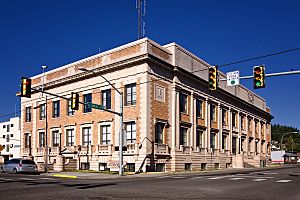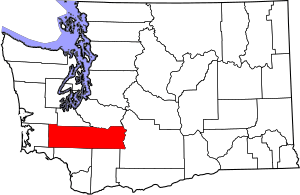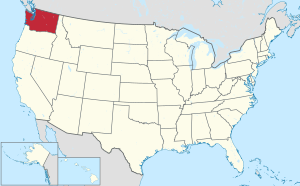Lewis County, Washington facts for kids
Quick facts for kids
Lewis County
|
|
|---|---|

Lewis County Historic Courthouse
|
|

Location within the U.S. state of Washington
|
|
 Washington's location within the U.S. |
|
| Country | |
| State | |
| Founded | December 19, 1845 |
| Named for | Meriwether Lewis |
| Seat | Chehalis |
| Largest city | Centralia |
| Area | |
| • Total | 2,436 sq mi (6,310 km2) |
| • Land | 2,403 sq mi (6,220 km2) |
| • Water | 33 sq mi (90 km2) 1.4%% |
| Population
(2020)
|
|
| • Total | 82,149 |
| • Estimate
(2023)
|
86,154 |
| • Density | 32.5/sq mi (12.5/km2) |
| Time zone | UTC−8 (Pacific) |
| • Summer (DST) | UTC−7 (PDT) |
| Congressional district | 3rd |
Lewis County is a county in the U.S. state of Washington. As of the 2020 census, the county's population was 82,149. The county seat is Chehalis, and its largest city is Centralia. Lewis County comprises the Centralia, WA Micropolitan Statistical Area, which is also included in the Seattle-Tacoma, WA Combined Statistical Area.
Contents
History
The county was created as Vancouver County on December 19, 1845, by the Provisional Government of Oregon, named for George Vancouver. In 1849, the county name was changed to honor Meriwether Lewis. At the time, the county included all U.S. lands north of the Cowlitz River, including much of the Puget Sound region and British Columbia. Despite the county being named for him, Meriwether Lewis never traveled in the present-day boundaries of Lewis County.
The initial establishment of a county seat was Claquato in 1862, the honor being relinquished in 1874 in favor of Chehalis. The first recognized court hearing in the Washington Territory was held in Lewis County at the John R. Jackson Courthouse, the oldest standing courthouse in Washington.
The county received official recognition as a "Purple Heart County" in November 2019.
Geography
Lewis County sits along the Interstate 5 corridor. Lewis shares a border with eight other counties. Clockwise from the top left, those are: Grays Harbor, Thurston, Pierce, Yakima, Skamania, Cowlitz, Wahkiakum, and Pacific counties.
According to the United States Census Bureau, the county has a total area of 2,436 square miles (6,310 km2), of which 2,403 square miles (6,220 km2) is land and 33 square miles (85 km2) (1.4%) is water. One of the world's tallest Douglas fir trees was in the town of Mineral within Lewis County, attaining a height of 120 metres (390 ft).
Geographic features
- Cascade Mountains
- Chehalis River and three of its tributaries, the South Fork Chehalis River, Newaukum River, the Skookumchuck River, along with several major creeks including Centralia's China Creek.
- Cowlitz River and its tributaries, including the Ohanapecosh River, Cispus River, and Tilton River.
- Nisqually River
- Lake Mayfield
- Riffe Lake
- Big Horn, the highest point in Lewis county
- Boistfort Peak, the highest point in the Willapa Hills
- Walupt Creek Falls
Major highways
Adjacent counties
- Grays Harbor County – north/northwest
- Thurston County – north
- Pierce County – north/northeast
- Yakima County – east
- Skamania County – south/southeast
- Cowlitz County – south
- Wahkiakum County – south/southwest
- Pacific County – west
National protected areas
- Gifford Pinchot National Forest (part)
- Mount Baker-Snoqualmie National Forest (part)
- Mount Rainier National Park (part)
- Mount St. Helens National Volcanic Monument (part)
- Goat Rocks Wilderness (part)
Communities
Cities
Town
Census-designated places
Unincorporated communities
Former communities
Demographics
| Historical population | |||
|---|---|---|---|
| Census | Pop. | %± | |
| 1850 | 558 | — | |
| 1860 | 384 | −31.2% | |
| 1870 | 888 | 131.3% | |
| 1880 | 2,600 | 192.8% | |
| 1890 | 11,499 | 342.3% | |
| 1900 | 15,157 | 31.8% | |
| 1910 | 32,127 | 112.0% | |
| 1920 | 36,840 | 14.7% | |
| 1930 | 40,034 | 8.7% | |
| 1940 | 41,393 | 3.4% | |
| 1950 | 43,755 | 5.7% | |
| 1960 | 41,858 | −4.3% | |
| 1970 | 45,467 | 8.6% | |
| 1980 | 56,025 | 23.2% | |
| 1990 | 59,358 | 5.9% | |
| 2000 | 68,600 | 15.6% | |
| 2010 | 75,455 | 10.0% | |
| 2020 | 82,149 | 8.9% | |
| 2023 (est.) | 86,154 | 14.2% | |
| U.S. Decennial Census 1790–1960 1900–1990 1990–2000 2010–2020 |
|||
2010 census
As of the 2010 Census, there were 75,455 people, 29,743 households, and 20,104 families residing in the county. The population density was 31.4 people per square mile (12.1 people/km2). There were 34,050 housing units at an average density of 14.2 units per square mile (5.5 units/km2). The racial makeup of the county's population: 89.7% white, 1.4% American Indian, 0.9% Asian, 0.5% black or African American, 0.2% Pacific islander, 4.0% from other races, and 3.2% from two or more races. Those of Hispanic or Latino origin made up 8.7% of the population. In terms of ancestry, 24.1% were German, 14.9% were Irish, 12.5% were English, 7.7% were American, and 5.1% were Norwegian.
Of the 29,743 households, 30.2% had children under the age of 18 living with them, 51.2% were married couples living together, 10.9% had a female householder with no husband present, 32.4% were non-families, and 25.7% of all households were made up of individuals. The average household size was 2.51 and the average family size was 2.97. The median age was 41.5 years.
The median income for a household in the county was $43,874 and the median income for a family was $53,358. Males had a median income of $43,695 versus $31,720 for females. The per capita income for the county was $21,695. About 10.3% of families and 13.3% of the population were below the poverty line, including 18.2% of those under age 18 and 8.6% of those age 65 or over.
Homelessness
Lewis County participates in the Point In Time Count (PTC), a census of the homeless population as required by law. Beginning in 2003 as mandated by the United States Department of Housing and Urban Development (HUD), the annual PTC, which tracks the number of individuals and families experiencing homelessness on a specified date, is usually held in January.
Homeless residents in the county were listed as 309 in 2012, falling to 205 in 2013. A count in 2018 reported 132 homeless residents, and following counts reported 161 in 2019, 142 in 2020, 120 in 2022, and 153 in 2023. There was no census of homeless residents taken in 2021.
Students and children under the age of 18 who are described as, "in an overnight accommodation insecure situation", are not officially recorded as part of the PTC, however a count in 2018 reported 558 students who meet the qualifications to be listed as homeless.
Economy
| Rank | Employer | Type of business | Number of employees |
|---|---|---|---|
| 1 | Providence Centralia Hospital | Health care | 900 |
| 2 | United Natural Foods | Food Wholesale/Distribution | 750 |
| 3 | Walmart | Retail | 653 |
| 4 | Lewis County | Government | 624 (2021) |
| 5 | Centralia School District | Education | 530 |
| 6 | Centralia College | Education | 472 |
| 7 | Chehalis School District | Education | 420 |
| 8 | Michaels | Distribution/Warehouse | 310 (2021) |
| 9 | Hamptons Lumber Mills | Timber | 305 |
| 10 | Braun Northwest, Inc. | Manufacturing | 275 |
Lumber production is a staple of the economy in Lewis County. The county annually produces 600,000 short tons (540,000 t) of dried timber while hosting 10 pulpwood production plants. Due to the region's biomass production capabilities, the county was the first in the state to receive a Bioeconomy Development Opportunity (BDO) Zone rating of AA by the BDO Zone Initiative. Lewis County is a leading producer of Christmas trees in the United States, with a yield of over 548,000 trees in 2022, which ranked sixth in the country.
A leading economic producer for the county is farming, with the region also holding large numbers for employment in mining, production, and warehousing.
Tourism is a large part of the Lewis County economy. In 2023, over 5.6 million people visited the county, an increase of 5.8% over the prior year. Over 45% of visitors came from outside the state and the most visited areas include Mt. Rainier and the shopping districts in the twin cities of Centralia and Chehalis. In collaboration with Discover Lewis County, a county-created tourism initiative, and the Economic Alliance of Lewis County, the county has focused on merchandise and online marketing, specifically promoting each town and city within its borders.
Reports from 2019-2020 list wages and incomes to be less than the state averages, with the median annual wages to be over $48,000 and a total household income of under $59,000. Unemployment is perennially moderately higher than the state average, though boom years in large Lewis County economic sectors can influence the employment levels. As of 2020[update], women held 48.6% of jobs in the county primarily in finance, health care, and education, where men held majority employment in such industries as construction, manufacturing, and utility jobs.
Arts and culture
Art
The county is home to the ARTrails of Southwest Washington initiative. The cooperative, begun in 2003, showcases local artists, art studios and galleries throughout the region, and holds an annual autumnal studio tour that incorporates events in smaller towns within Lewis County. The Lewis County Historical Museum hosts a permanent ARTrails gallery. and Centralia is home to the nexus of the event and an ARTrails-owned gallery.
Charitable organizations
The Lewis County branch of the American Association of University Women (AAUW) has been in existence since 1923. The organization has held an annual used book sale since 1979. The proceeds help to fund scholarships, day camps, film festivals, and career days for young women in middle and high school.
Education
The county is home to Centralia College, founded in 1925. Located in the middle of Centralia, it is the oldest continuously operating community college in the state.
Parks and recreation
As of 2022[update], Lewis County directly oversees 164.0 acres (66.4 ha) of parks. Recreation areas and sites under the auspices of the Lewis County Parks and Recreation Department include Adna's Back Memorial Park and Rose Parks, Centralia's Schaefer County Park, Claquato Church, Cowlitz River Park (Packwood Park), South County Regional Park in Toledo, and St. Urban Church. The county honors the travels of pioneer Ezra Meeker on the Oregon Trail with several historical markers throughout the region.
The Lewis County Historic Bike Ride is an annual, mid-spring fundraising event that began as a county-held historic celebration in the early 1990s. The ride starts in Mary's Corner and through a variety of course options, participants can travel to several small towns and communities in the county and can bike through Centralia and Chehalis. The route is often used as a warm-up by riders of the Seattle to Portland Bicycle Classic (STP).
In 2010, the county declared that all parks under its jurisdiction were to be "No Shooting Zones".
Infrastructure
The Lewis County Public Utility District (LCPUD) provides electricity to the county. In 2024, the LCPUD became a broadband internet service provider, offering high-speed internet to the region via a federal grant. The project, meant specifically for rural residents in the county, is expected to be completed in late 2027.
Renewable energy
In late 2023, the county was announced as part of the Pacific Northwest Hydrogen Hub (PNW H2) initiative through the U.S. Department of Energy. Lewis County would be utilized for the production and storage of hydrogen fuels, including the potential manufacturing of related hydrogen fuel products, such as vehicles and fuel cells. The PNW H2 has provided grants to several economic and educational areas in the county, including funding to school districts, Centralia College, Puget Sound Energy (PSE), and various renewable energy companies. Lewis County Transit was awarded a grant from the program, becoming the only transit agency in the United States to receive funding from the hub program.
Lewis County is the location of the Skookumchuck Wind Farm which contains 38 wind turbines that can generate a maximum of 138.6 megawatt-hours (499 GJ). The 22,000-acre (8,900 ha) site became operational in late 2020 and the energy produced is used through PSE's Green Direct program.
See also
 In Spanish: Condado de Lewis (Washington) para niños
In Spanish: Condado de Lewis (Washington) para niños

